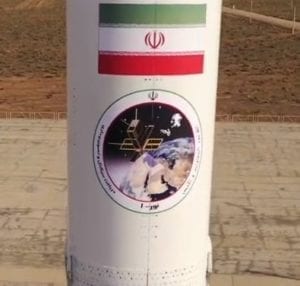
Iran’s Islamic Revolutionary Guard Corps (IRGC) has unveiled the existence of its own Space Command following the successful launch of the Noor-1 Earth observation satellite on 22 April 2020 (reported by SpaceWatch.Global here).
After the launch of Noor-1 IRGC commanders appeared in Iranian media extolling their achievements and speaking about future ambitions. Among those featured in media interviews were Major General Amir-Ali Hajizadeh, the commander of the IRGC Aerospace Force, and Brigadier Ali Jafarabadi, a previously unknown figure who was cited as the commander of the IRGC’s Space Command.
Until the appearance of Jafarabadi on Iranian media the existence of the IRGC Space Command was unknown, at least in open sources.
In his Iranian television interview, Jafarabadi mentioned that his command is working on “larger” satellites for higher orbits that will serve communications and navigation functions, and also mentioned that a Noor-2 satellite will be launched in the near future.

In addition to the revelation of the existence of the IRGC Space Command and the identity of its commander, a number of new details have emerged about the Noor-1 satellite and its Qassed satellite launch vehicle.
A photograph appeared of a previously unseen decal on the side of the Qassed SLV’s faring that depicts what appears to be a 6U CubeSat. If the illustration on the decal is representative of the Qassed SLV’s payload, then it seems that the Noor-1 is a 6U CubeSat.
While the IRGC has described the Noor-1 as a military reconnaissance satellite, it is likely that the camera resolution of the Noor-1 is of limited military utility unless IRGC engineers have made significant technological breakthroughs in camera miniaturisation.
Further, amateur satellite operators around the world have since been able to track Noor-1 in its Sun-synchronous orbit (SSO) at 425 kilometres altitude, and have reported that they have detected radio signals transmitted from the satellite suggesting that, for now at least, it is operating.
There have also been revelations about the previously unknown Qassed SLV. It appears that the three-stage rocket is a hybrid of the Iranian Ghadr-110 medium range ballistic missile (MRBM) that comprises the liquid-fueled first stage, and the experimental Salman solid-fueled rocket engine (first revealed in February 2020) that comprises the second stage, and an unknown kick motor for the third stage.
In a 23 April 2020 interview on Iranian television, IRGC Aerospace Force commander Major General Hajizadeh said that the liquid-fueled Ghadr was used as the first stage as a temporary solution for testing the Salman solid-fueled stage in an SLV mode. Hajizadeh then added that the IRGC will in future use a wholly solid-fueled variant of the three-stage Qassed.
Should the IRGC eventually develop a wholly solid-fueled variant of the Qassed SLV then it will be a relatively easy step to develop a medium or even intermediate range ballistic missile.
 SpaceWatch.Global An independent perspective on space
SpaceWatch.Global An independent perspective on space




